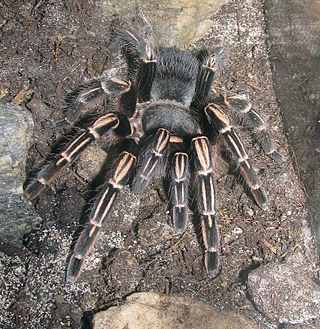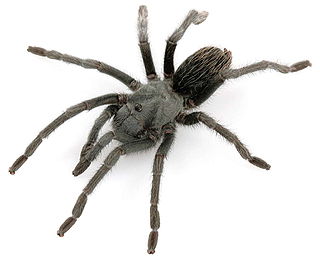
Aphonopelma is a genus of tarantulas native to the Americas. It includes nearly all the North American tarantula species north of Mexico and a considerable percentage of the tarantula species that range into Central America. Most are fairly large tarantulas with leg spans of 6 in (16 cm) or more. Like most New World tarantulas, all species of Aphonopelma have urticating hairs. Despite their fearsome appearance, these tarantulas are not harmful to humans and some species are popular in the pet trade. With about 90 species described so far, Aphonopelma comprises about 10% of the total number of described tarantula species. However, their taxonomy is poorly understood and species are difficult to tell apart, especially those that are brown or black without other pattern. Therefore, the actual number of species is unknown, with more species likely to be identified in the near future. In captivity, they are usually fed crickets; in the wild, they eat most insects, including crickets, grasshoppers, cockroaches, mantises, and beetles.

Aphonopelma chalcodes, commonly known as the western desert tarantula, desert blonde tarantula, Arizona blonde tarantula or Mexican blonde tarantula, is a species of spider belonging to the family Theraphosidae. It has a limited distribution in the deserts of Arizona and adjacent parts of Mexico but can be very common within this range. The common name "blonde tarantula" refers to the carapace, which is densely covered in pale hairs, and contrasts strongly with the all-dark legs and abdomen. Additionally, these spiders have low toxicity, a long life expectancy, and several offspring.

The Aphonopelma hentzi, also known as Texas brown tarantula, Oklahoma brown tarantula, or Missouri tarantula, is one of the most common species of tarantula living in the Southern United States today. Texas brown tarantulas can grow to leg spans in excess of 10 cm (4 in), and weigh more than 85 g (3 oz) as adults. Their bodies are dark brown, though shades may vary between individual tarantulas. The colors are more distinct after a molt, as with many arthropods.

Aphonopelma anax, commonly known as the Texas tan tarantula, is a species of spider belonging to the family Theraphosidae native to southern Texas and northern Mexico.
Aphonopelma hollyi, also known as the Lubbock gold tarantula, is considered by some sources to be a species of tarantula native to Texas in the United States. Described in 1995, the scientific name honors the 1950s rock-and-roll singer Buddy Holly. Other sources suggest spiders given this name are actually Aphonopelma hentzi.
Aphonopelma chamberlini, also known as the Paso Robles rusty red tarantula, is regarded by some sources as a tarantula species endemic to California, and by others as synonymous with Aphonopelma iodius.

Aphonopelma johnnycashi is a species of tarantula. It was found in 2015 near Folsom Prison in California and named after Johnny Cash, whose song "Folsom Prison Blues" made the prison famous. Mature males are generally black, and the country music singer was also known as "The Man in Black".

Aphonopelma armada is a species of spider in the family Theraphosidae, found in Texas in the United States.

Aphonopelma atomicum is a species of spiders in the family Theraphosidae, found in United States. Like many New World tarantulas, they flick urticating hairs at attackers if threatened.

Aphonopelma peloncillo is a species of spider in the family Theraphosidae, found in the United States.

Aphonopelma steindachneri is a species of spider in the family Theraphosidae, found in United States (California) and Mexico.

Aphonopelma eutylenum, commonly called California ebony tarantula, is a species of spider in the family Theraphosidae, found in the United States (California).

Aphonopelma gabeli is a species of spider in the family Theraphosidae, found in United States.

Aphonopelma icenoglei is a species of spiders in the family Theraphosidae, found in United States (California).

Aphonopelma iodius is a species of spider in the tarantula family Theraphosidae, found in United States. A 1997 paper combined it with three other previously described species into a single species, calling it "A. iodium". However, iodius is a neuter comparative adjective and is the correct form. Aphonopelma smithii has also been synonymized with A. iodius. A. iodius is common in the Mojave Desert to the west of the Colorado River.

Aphonopelma joshua is a species of spider in the family Theraphosidae, found in United States (California).

Aphonopelma mojave is a species of spider, in the family Theraphosidae (tarantulas).

Aphonopelma vorhiesi is a species of spider in the family Theraphosidae, found in Arizona and New Mexico. This species looks similar to the Aphonopelma chalcodes, but it is far more rare in captivity.

Aphonopelma mareki is a species of spider in the family Theraphosidae, found in United States.
Aphonopelma phasmus is a species of spider in the family Theraphosidae. It is only known from a single adult male collected near the Colorado River in the Grand Canyon National Park in Coconino County, Arizona. The female is unknown.

















